Playgroup Brews - Guilds of Ravnica (Pt 1)
The Authors' Brew
Howdy howdy everyone! I may be busy with graduate school, but I still have time to bring you articles! I took a little break to get settled in, but decided it was time to come back, and what better to choose than a Playgroup Brews timed with our revisit to Ravnica? Ravnica holds a special place in my heart as one of my favorite planes, yet it is a setting I never got to experience during a release, since I started with Theros. I’m super thrilled to be able to review how these commanders may play out with this wonderful format.
We ran a Twitter poll and the readers have asked to see all five guilds for this brewing session, so we've picked one commander from each guild to discuss this time around! We’re also going to have a post-playtesting review of how these commanders tested in-game against each other! Today we will be looking at three lists.
Now let’s meet this round’s authors. They are all new to Playgroup Brews, but not new to EDHREC! It’s time for some of our other writers to get a piece of the action here! Without further ado, let’s see who's joining us this time, which commanders they picked, and why! Welcome to this set's edition: The Authors' Brew!
Brief Intros:
Christian: As you all know, I'm the author of this article series, along with the Scrambleverse and now Evolutionary Leap! I like janky decks that do interesting things, and my first deck I ever built was a Nekusar, the Mindrazer wheels deck, so I wanted to go back and take another stab at something similar with Niv-Mizzet, Parun!
Mason: Hello! I’m Mason, and I am the author of the Underdog’s Corner. Outside of playing Magic, I consider myself an avid Vorthos, but when it comes to deck building, I really enjoy brewing commanders that require a little bit more thought and digging to build. That would explain why I write the series I do, and it would explain why I will be talking about Emmara, Soul of the Accord!
Willem-Jan: I’m Willem-Jan, a new author for EDHREC. I’ve recently started the Shape Anew series and am slowly boarding the article-writing train. I’m a Melvin by Magic characteristics, where I like the numerous interactions cards provide. I’ll be tackling Aurelia, Exemplar of Justice to find out if some of these interesting interactions can pop up from a Boros commander.
Dean: I'm Dean, author of the now-sporadic Dig Through Time series, and many a set review. As a Melvin, I enjoy underused tech and tend to build Voltron, control, prison, discard, or Rube Goldberg combo decks. Etrata, the Silencer seemed like an interesting take on Voltron and control, so that's who I brewed. I hope you enjoy!
Bernardo: Hello, I’m Bernardo, and I’m the madman behind the new series, Epic Experiment! I enjoy the creative process of deck building and exploring the boundaries of each commander. I’m usually in between spellslinger and artifacts decks, with the occasional Voltron. Izoni, Thousand-Eyed caught my eye because she has a powerful ability that can be built around (and abused) in many ways, so let’s see what we can come up with!
Now that we’re all acquainted, let’s see what Bernardo, Willem-Jan, and Dean came up with in this first installment!
First Impressions: Izoni, Thousand-Eyed
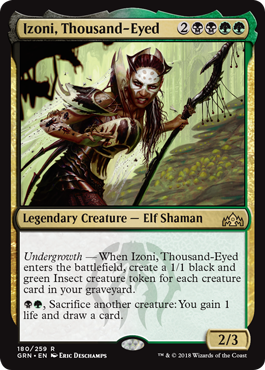
Christian: I don’t have much experience with graveyard decks outside of my The Scarab God Zombies and a little bit with Slimefoot, the Stowaway. I’m interested to see where this goes, but am not completely sure what to make of it yet or how to capitalize on her ability.
Mason: It looks like we’re continuing the tradition of heavily-colored mana costs. She reminds me a lot of Ishkanah, Grafwidow, who I’ve written about, and I think she’s a little bit better outside of combo lines. Honestly, I would love to try her out with 30+ Rat Colony just once. I like her ability, but the color intensity makes it less useful.
Willem-Jan: If any color can take serious advantage of tokens, it’s Golgari. Even Izoni herself provides a way to abuse them. If any color combination can handle the high mana cost, it’s Golgari as well, so I’m interested in seeing the direction this deck will take.
Dean: You’ll see in part two that I like Niv-Mizzet despite his mana cost, so I'm aware of the irony of the following statement: I think Izoni is too greedy for colors. Double-black and double-green to cast, with an activated ability that also costs GB each time... that really just kills it for me. I like my sac outlets to be free or cheap, and Izoni isn’t.
Bernardo: Her mana cost may scare people away, but I don’t think that should be the case. Those brave enough to embrace her will be able to abuse both the grinding value of having those tokens as resources and the explosiveness of being able to create an army out of nowhere. Let’s see what we can make of this.
Bernardo’s Izoni Deck Tech:
Welcome to the swarm! As I thought, Izoni's ability is very strong in the right shell. Self-milling in Golgari feels very natural because we don't have to go through hoops to get cards in our graveyard. Satyr Wayfinder is a good example. At first he looks like a worse Sylvan Ranger, but after considering the reliability of hitting at least one land and adding the mill aspect of the card, we can see how much better he is. In this deck, we're constantly getting value from creatures, from them entering the battlefield to them being sacrificed. Izoni's ETB is the icing on the cake; it allows us to recover from a board wipe, get value from sacrificing the tokens, and also let us swarm our way to victory. The thing I liked the most in Izoni is that she makes us build around her, but at the same time the deck functions well without her.
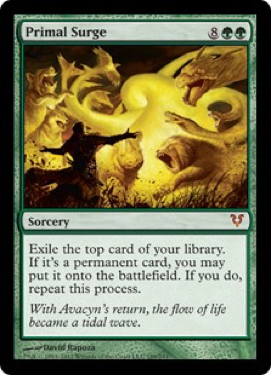
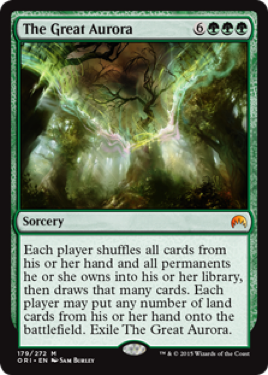
Given the nature of Undergrowth, I saw the need to invest heavily into creatures. Because of this, I saw an opportunity to make this interesting, but demanding, using Primal Surge. Since we're only using two nonpermanent cards, Primal Surge and The Great Aurora, resolving it means that we're putting most if not all of our deck directly into play for a variety of game-ending effects. It was very natural to build the deck like this, and, in a way, it rewarded me for that choice, although I can see how this deck would benefit from some nonpermanent cards such as ramp or removal.
As a consequence of the higher number of creatures, this deck has an impressive Birthing Pod chain. Getting Wirewood Symbiote off an Insect token and having the ability to bounce Izoni is very powerful and can get out of control really fast if left unchecked. We can also sacrifice Izoni to get Protean Hulk to combo off, or Avenger of Zendikar to get Craterhoof Behemoth on the next activation. Endless possibilities.
![]()
Most of our noncreature slots are there to support our main gameplan. Spells like Attrition and Grave Pact are a constant source of creature removal. Panharmonicon and Blade of Selves provide more value to each of our creatures, including Izoni, both of which are even more explosive with Parallel Lives. Cryptolith Rite and Song of Freyalise allow some insanely explosive turns if played after our commander.
For finishers, we have many tools in our disposal, from the classic tokens + Craterhoof Behemoth/Thunderfoot Baloth line, to the more direct approach of recurring Lotleth Giant to snipe people out. Kessig Cagebreakers is a fun one. It's a very fast clock that is basically on theme with our commander. We have the flexibility to add some infinite combos to tutor with Protean Hulk, such as Mikaeus, the Unhallowed+ Walking Ballista, that may prove useful in more tuned tables (though remember you need an additional sacrifice outlet, since Mikaeus gives the Ballista +1/+1).
One thing that can disrupt us is graveyard hate. It doesn't completely stop us because most of our creatures provide us value even without a graveyard, but still a Bojuka Bog can set us back if we spent a turn or two putting cards in the graveyard.
Overall, this is a solid list, that can adapt to almost any meta, and in my opinion, it may be more fun than Meren of Clan Nel Toth, who plays many of the same cards. They may play similar strategies, but Izoni is clearly less oppressive, has more ways to build around, and can be more explosive than Meren. Below you can find my list!
First Impressions: Aurelia, Exemplar of Justice
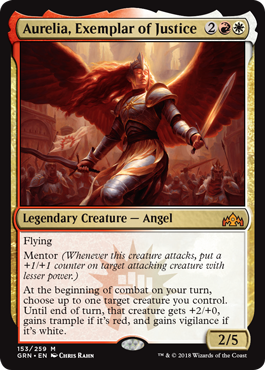
Christian: This makes me think of the Lorwyn Lieges, except… worse? Giving a buff to a creature based on colors is definitely interesting, but I think Wizards needed to take it another step up in order to make this a viable commander, which is a common theme among Boros legends.
Mason: Sigh. How the mighty have fallen. She’s a four-drop 4/5 vigiliant flying trampler, and she'll Mentor most of the time, I think. That’s very aggressive. However, the gears kept turning for me. I think there’s some interesting lines of play with Mentor, given that she is a two-power commander, and she rewards playing multicolor creatures.
Willem-Jan: Well, here we are again with a buffing commander. Interestingly though, it might be one of the best yet, as Aurelia comes down early (she’s the cheapest among Boros Angels) and doesn’t need others to function. I think people underestimate her!
Dean: Poor Boros…
Bernardo: She is a good beater and synergizes well with extra combat steps. Can be an “effective” Voltron commander with double strike. Nothing new to Boros, though...
Willem-Jan’s Aurelia Deck Tech:
I understand that Boros has a few problems becoming a cornerstone of Commander. Generally, the guild is ranked as the weakest among guilds for EDH. Today, I’m here to convince you Boros is as strong and unified as the lore wants you to believe. Maybe even more so! Let’s dive into her abilities.
As noted before, she’s relatively cheap for a Boros commander. This is great, because one of Boros’s biggest weaknesses is their inability to ramp properly. Here, a low curve makes Aurelia, Exemplar of Justice less dependent on our ability to draw lands, and generally gives the opportunity for a low-curve deck. The other abilities of Aurelia focus on power: both the Mentor ability and +2/+0 trigger facilitate an increase in power for a single creature. But who would benefit from a power buff? That would be Fencing Ace and his double striking friends.
Yes, today we’re striking double and we’re striking true. Double strike is an ability that really enjoys more power, and it’s almost exclusively featured in Boros. Hearthfire Hobgoblin, Boros Charm and the new Swiftblade Vindicator are great examples of this. Most years we can expect an efficient new double striker to see print, so this deck can also be expected to strengthen with every set and not just depend on the strategies introduced in Guilds of Ravnica.
So, what to add beyond that? Well, more of the same: power buffs. We want our creatures to be so ripped they don’t fit through the door. Luckily, this is the second area of expertise for Boros. Ogre Battledriver gives 2 power and haste, Jor Kadeen, the Prevailer gives 3 power if we have 3 artifacts, and Rally the Peasants gives 2 power, twice, at instant speed! The accumulating amounts of damage cannot be matched by any other guild! Equipment, another favorite strategy of Boros, can be another source of great power and responsibility. Sunforger is already a fan favorite among the Boros legion, and it does double duty here.
Equipments offer a second synergy with double strikers: combat damage triggers. Bloodforged Battle-Axe and Mask of Memory are triggered twice by a creature like Iroas's Champion. Even more so, Sword of Fire and Ice or Sword of Feast and Famine provide protections on top of their damage triggers and the power buff (though remember that protection from Aurelia's colors will prevent her from buffing the equipped creature, including herself)! The efficiency really goes through the roof. Slap on another effect like Waves of Aggression (that also synergizes with Aurelia’s triggers) to double all of our doubled effects. No Dimir backstabbing, no Golgari grave-crawling, no Izzet spellslinging, and no Selesnya tree-hugging. Just. Pure. Boros. Face smashing.
First Impressions: Etrata, the Silencer
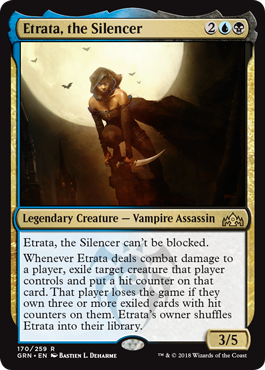
Christian: If there was ever a commander to personify jank, this would be a contender. This just screams doing stupid things to capitalize on her ability. I like the concept, and can really get behind this as a commander, though I don’t expect to see her in the 99 of many decks.
Mason: This is just weird, but what an awesome ability. I’m definitely going to have an Underdog’s Corner about her in the near future. I think there are ways to get around her ability, such as copies and clones, but I think I’ll pass on her for now.
Willem-Jan: Etrata has awesome interactions with the stack, where she can be made to change zones in response to her own ability. Sac, bounce,and blink away! That type of deck hasn’t really popped up in Dimir, but I’m not sure that’s the type of deck most people would create with her.
Dean: Etrata is exactly the kind of weird, janky Voltron strategy I'm pulled towards. I ended up brewing her for this article, and I have to say there are a lot of different ways to focus around her ability and capitalize on its potential.
Bernardo: Another interesting Dimir commander released in a recent set. She brings her own twist to the color pair and is very flexible in both gameplay and deckbuilding. There’ll be times where she’ll feel clunky, especially without a bounce/flicker effect to keep her after a hit, but her kit is unique enough to make it worth it.
Dean’s Etrata Deck Tech:
Etrata, the Silencer sits in a weird place. She’s a three-hit Voltron commander unlike any other. However, she doesn’t really benefit for power-boosting effects, and she can’t win the game (easily) unless your opponents are running creatures.
Etrata’s ability can be confusing. I read her twice and then needed to hash out the finer details of her ability with my playgroup before I fully understood how she worked. Whenever she hits an opponent, she exiles one of their creatures and then shuffles herself into your library. There are ways around this, however; Etrata does not need to be on the battlefield when her ability resolves, so you can shift her around to avoid getting shuffled while still exiling creatures. That’s the crux of the build, so let’s take stock of our options.
How to get around Etrata’s drawback:
-
- Bounce effects are fine, but not ideal. You’ll have to pay for the bounce effect and then pay to recast Etrata, which can be clunky and expensive. Cards like Words of Wind and Curfew, though tempting, let opponents keep their creatures off the battlefield, when we want to be exiling them.
- Flicker is one of our best options in that it’s very cheap. Cards like Ghostly Flicker save Etrata and reset a land or mana rock, which is nice. They won’t work in my build, but Deadeye Navigator is, of course, an all-star, along with Nephalia Smuggler. For my money, it’s all about the cheap cards like Siren’s Ruse and Essence Flux.
- Phasing is our second-weirdest option. Vodalian Illusionist and Vanishing are our two options for repeatable phasing. Reality Ripple is one and done, but all three are very good. At least as good as flicker.
- Ninjutsu is our weirdest option, and it might fit under 'bounce,' but it’s a little different. Etrata is technically attacking and unblocked even after she deals damage and her ability goes on the stack, so you can activate the Ninjutsu ability of a Ninja like Silent-Blade Oni to put her back in hand before she shuffles in. If Etrata has first strike, a second combat damage step is created and your Ninja can deal combat damage in addition to Etrata.
These are the effects we have at our disposal, but if you’re newer to the game or unfamiliar with the stack, it may not be apparent how this all fits together. Etrata’s ability is all one trigger, so you don’t respond to the self-shuffle clause individually. Instead, you just respond before any of Etrata’s ability resolves. With her ability on the stack, already targeting a creature to exile but not yet resolving, activate or cast a card with one of the listed effects. Etrata will go to the new zone before her ability resolves. Now her ability resolves, the creature gets exiled with a hit counter, and Etrata is either not around to get shuffled in, or she’s a new game object on the battlefield and the ability has no game memory of her.
I initially misread Proteus Staff; I thought you could use it at instant speed to get around Etrata’s downside. Alas, it’s sorcery speed only. Still, the card intrigued me, and I decided to go with a creatureless deck to abuse it. When you use the Staff on the only creature in the deck, you get to cycle through all those cards, putting that creature back into play, and putting everything else back on the bottom of your deck in any order. Since 'everything else' is 'your entire deck,' you get to put your entire deck on the bottom of your deck in any order, effectively allowing you to reorder the whole pile however you want! Resolving it once means you can go get Helm of the Host, Mirror Gallery, Blade of Selves, Rite of Replication, etc., allowing you to swarm your opponents with copies of Etrata and ending the game in short order.
The rest of the deck is a somewhat standard control shell with removal and counterspells to protect Etrata and the combo pieces. There are also a ton of card draw spells and a healthy sprinkling of tutor effects so the deck doesn’t just gutter out.
The deck has a few weaknesses, including enemy decks that run heavy tokens, or Voltron or spellslinger brews that don’t offer many targets for Etrata exile. Remember, exiling an opponent’s commander with Etrata won’t do a whole lot for your win-con, since the hit counter won’t stick. Tokens also won't stay exiled with counters on them, because they cease to exist as soon as they reach exile. For these decks, you’ll need a swarm of Etratas to beat them down with combat damage. Those are going to be some slow games, but not unwinnable. After all this, let's see what I came up with!
The End Step
Well, thats the first portion of this edition of Playgroup Brews! It's been really awesome changing things up this time and getting some fellow authors involved. These decks are absolutely bonkers, really fun, and each one has its own gimmick that makes it unique! Look forward to Part Two very shortly!
What did you think of these decks? In a game against each other, which would you expect to come out on top? Do you have any other ideas on how you can capitalize on these commanders' abilities? Let us know in the comments below! Thanks!
Your opinions are welcome. We love hearing what you think about Magic! We ask that you are always respectful when commenting. Please keep in mind how your comments could be interpreted by others. Personal attacks on our writers or other commenters will not be tolerated. Your comments may be removed if your language could be interpreted as aggressive or disrespectful. You may also be banned from writing further comments.
